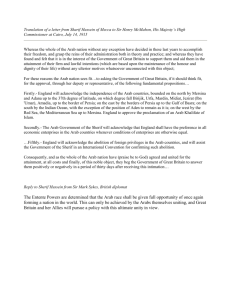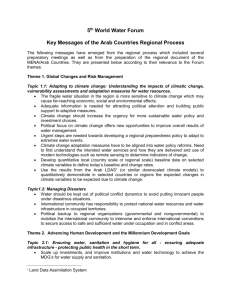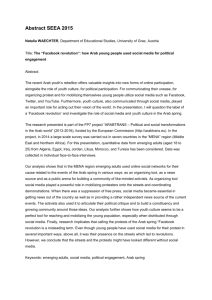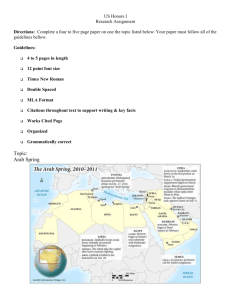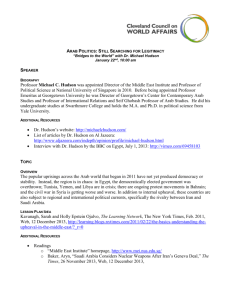Abstract - Human Resource Management Academic Research Society
advertisement
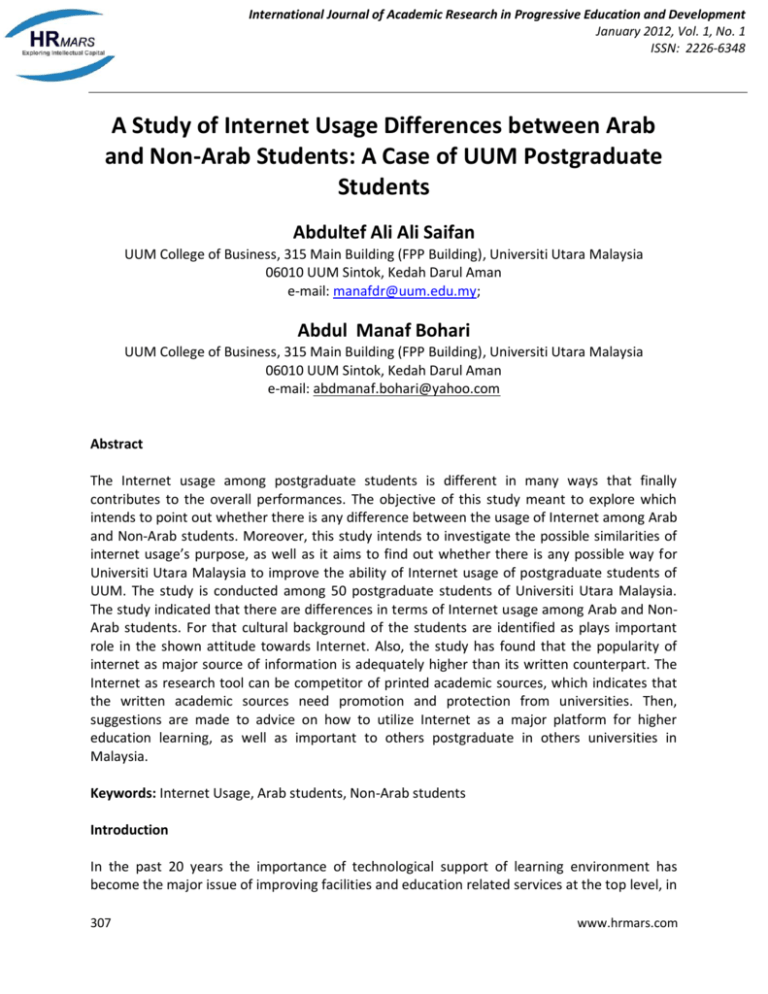
International Journal of Academic Research in Progressive Education and Development January 2012, Vol. 1, No. 1 ISSN: 2226-6348 A Study of Internet Usage Differences between Arab and Non-Arab Students: A Case of UUM Postgraduate Students Abdultef Ali Ali Saifan UUM College of Business, 315 Main Building (FPP Building), Universiti Utara Malaysia 06010 UUM Sintok, Kedah Darul Aman e-mail: manafdr@uum.edu.my; Abdul Manaf Bohari UUM College of Business, 315 Main Building (FPP Building), Universiti Utara Malaysia 06010 UUM Sintok, Kedah Darul Aman e-mail: abdmanaf.bohari@yahoo.com Abstract The Internet usage among postgraduate students is different in many ways that finally contributes to the overall performances. The objective of this study meant to explore which intends to point out whether there is any difference between the usage of Internet among Arab and Non-Arab students. Moreover, this study intends to investigate the possible similarities of internet usage’s purpose, as well as it aims to find out whether there is any possible way for Universiti Utara Malaysia to improve the ability of Internet usage of postgraduate students of UUM. The study is conducted among 50 postgraduate students of Universiti Utara Malaysia. The study indicated that there are differences in terms of Internet usage among Arab and NonArab students. For that cultural background of the students are identified as plays important role in the shown attitude towards Internet. Also, the study has found that the popularity of internet as major source of information is adequately higher than its written counterpart. The Internet as research tool can be competitor of printed academic sources, which indicates that the written academic sources need promotion and protection from universities. Then, suggestions are made to advice on how to utilize Internet as a major platform for higher education learning, as well as important to others postgraduate in others universities in Malaysia. Keywords: Internet Usage, Arab students, Non-Arab students Introduction In the past 20 years the importance of technological support of learning environment has become the major issue of improving facilities and education related services at the top level, in 307 www.hrmars.com International Journal of Academic Research in Progressive Education and Development January 2012, Vol. 1, No. 1 ISSN: 2226-6348 every competitive economies. There are social and economical needs for high skilled graduates. In this manner, the higher learning institutions have to observe their way of teaching, and the effectiveness of their system. In this case, internet has been considered as major information resource in the 21st century. Since internet seems to be more effective information resource than anything before, moreover it results that new behaviors are emerging on the side of internet usage. This study is meant to be an inner introduction to the experimental discovery of human behavior towards internet usage. This study aims to point out the possible differences among different people, by creating categories through which these possible differences and similarities can be exemplified. Since University Utara Malaysia has many postgraduate students, and the majority of postgraduate students are coming from Arabian countries, we have to measure and conduct a study, on how these students use the internet within the campus, moreover it has to be explored, whether there is any significant difference in the usage of internet between Arab and Non-Arab students. Internet has given so many opportunities to students as well as to lecturers to enlarge the students’ capabilities moreover to build a secondary learning environment by which the taught knowledge can be exploited more widely. At the very moment, when we talk about the internet and its usage among students at University Utara Malaysia, we can differentiate some habit in the usage of internet. Internet has the ability for international students to keep in touch with their loved one, it has the ability, to provide an invisible hand while the lecturers are away, and it has the possibility to open up new possibilities day by day for learners, teachers and learning institutions. Due to globalization, there is tremendous information flow from one point of the earth to another. There is rapidly increasing number internet users year by year. Higher leaning institutions have to join into this information flow, to be competitive on local as well as international level. The background of the problem, why this study is conducted is that there is a need for higher learning institutions to upgrade their facilities from time to time, since the education is considered as very lucrative industry, in which competition exist among higher learning institutions. Since there is competition, there is demand from each side of the balance. There is need from students to have good facilities, while there is need from universities to get good number of students, who possess competitive knowledge, therefore both side can fulfill its requirements. Since the university would like to improve its facilities, but before it begins its further development, they need to investigate the scale of the development, which derives from the usage of internet of university students. University Utara Malaysia has high number of Arab students; therefore they can represent one group of the research, while their quality and quantity of usage can be compared to Non-Arab students. The usage of internet among Arab and Non-Arab students can be different due to cultural differences, or differences in ethnical and social level which derives from the different educational and social background. Therefore this study has to be conducted, in order to come out with an adequate answer whether there is any difference in term of internet usage among Arab and Non-Arab student or not. This difference can enhance the scale of development, and the quality of facility development on the university which enables all higher learning institutions which are having students from different nations to conduct their development according to the findings of this research. 308 www.hrmars.com International Journal of Academic Research in Progressive Education and Development January 2012, Vol. 1, No. 1 ISSN: 2226-6348 Problem Statement The main problem of this study is the possible differences which are coming from the diversity of nations that represents different cultural values, way of interpretation and scale of usage of learning tools. In this stage of the study, we can point out several problems. For instance, the number of international students is creating a new point of view in education industry; moreover it requests new approaches in order to be able to deliver the necessary knowledge. The following examples will give an introductory part of the problems which are basically surrounding the main topic of this discussion. For example, the students are not used to with the usage of internet; therefore they don’t have expertise how to use it properly. It can derive from the lack of infrastructural development, which surrounds the student in their place of origin. Another example, whereby the country of their origin has no internet facility at all, in this case the students most likely does not know how to use internet facilities efficiently. The second is the non academic purpose usage which means they are using the internet but not in the manner, which is expected from a graduate student. It is the misusage of internet, when they download games, software. This is a non-academic purpose. Moreover there is demand for higher speed and reliable internet service, when it comes to IT field. Some of the IT experts who pursue their studies at Universiti Utara Malaysia require high speed internet connection, in order to be able to test their projects, and do their research which requires strong technological background. Objective of Research The objectives of the study are: (a) To exemplify the differences, if there is any, in the usage of internet among Arab and NonArab students. (b) To explore the quality of usage of internet for them especially for academic purposes. (c) To exemplify whether there is any role of the university to educate the students for the proper usage of internet technology. Methodology of Research This research is based on theoretical studies, as well as based on empirical study, which enables to use questionnaire and collect adequate data from potential users of internet. It is very important to apply both studies, because the two types of studies will form one collective platform to exemplify and reflect the outcome of the research to the research questions. The two types of studies enable to combine real mass data with theoretical support in order to come out with adequate answer for the research questions. In this study different type of data were being used to create analytically suitable database from mass data into statistical data. Unfortunately, there was no significant study conducted in this field, but many empirical and statistical studies were conducted on the field of internet usage and computer usage, therefore these studies will be reflected as references in this study. There are quite similar studies 309 www.hrmars.com International Journal of Academic Research in Progressive Education and Development January 2012, Vol. 1, No. 1 ISSN: 2226-6348 regarding internet usage among different nations, but particularly differences between races are very limited. In this research demographical data is used to screen and exemplify the profile of the respondents, and statistical data were gathered in order to exemplify behavioral differences in the usage of internet among Arab and Non-Arab postgraduate students at University Utara Malaysia. In this research there is one group of people will be interviewed, which is postgraduate students at UUM, with one restriction, which is that there must be Arab and Non-Arab students among the interviewee, adequately on same number in terms of population. The number of postgraduate students is 50. Among these 50 respondents 25 is Arab and 25 is classified as Non-Arab postgraduate student. Overall, variables and item that will be used are shows in Table 1. Table 1: Variables, Dimension, and Sources of References. Variables Dimension Source of References Duration of internet usage Time scale Total item: 50 Simon Mercado, Richard Welford & Kate Prescott (2001) Frequency of internet usage Purpose of usage How long students use internet (effectiveness of internet usage) Total item: 50 How often respondent use internet Total item: 50 Gregory L. Rosston, & David Waterman (1996) Bolles (2003) Research Findings Profile and Basic Characteristics of Respondent’s There are several characteristic which determines the quality of the respondents. First of all there were 25 Arab and 25 Non-Arab postgraduate students who have taken participation in the survey. This is important to note that the number of the Arab and Non-Arab students is the same since this survey investigates the possible differences among these two races. In order to observe the attitudes of these two groups, there must be the same number of participant from each race. Since both races have represented itself equally the study could be carried out effectively. In fact, this study has questioned fifty interviewees, but only few of them were female, the dominance of the male respondents is relatively high. The number of the male respondents was thirty-seven while the number of female respondents was thirteen. In addition, based on college, the respondent’s are attached to College Of Business (22 respondents), College of Art and Sciences (21 respondents) and College of Law, Government 310 www.hrmars.com International Journal of Academic Research in Progressive Education and Development January 2012, Vol. 1, No. 1 ISSN: 2226-6348 and International Studies (7 respondents). In term of age, most of them are 25 – 30 years (22 respondents), 20 – 25 years (10 respondents) and More than 30 years (18 respondents). Spending time on Internet is important characteristics for respondent where as indicates that most of the students are spending 21-28 hours online, while there is also tremendous number which students are always online. In the group of always online those students are classified which have spent online more than 4 hours a day. It is huge number, if we think about that 32% of the student are online almost every day for four hours, plus there is 26% of the respondents answer indicated that they are online more than four hours a day, that means there is 58% of the respondents who generally classified as addicted respondents, since the average sleeping time is 8 hours, plus 4 hours online, therefore half of their day has gone. It shows that there is quite high number of students who are unable to do other activities, such as sport, or outdoor activities due to their addiction and engagement of internet. In addition, there are five major activities which are widely accepted as purpose of internet, as shown in Table 2 and Table 3. Table 2: Duration of Internet Usage. Obviously noticeable, among non Arab-student the number of females relatively high, while among non-Arab students this number is very low. In this case we can surely say that it has cultural aspect, therefore it indicates that Arab females have lower access to internet than male Arabs, and so they have lower access to internet compare to non-Arab females. Another interesting thing can be noticed, which is that the age of the Arab participant falls into the group of 25-30 years, while in non-Arab group it falls into 20-25 years and more than 30 years group. In the following charts we will get a closer look about the real attitudes towards internet and the differences among Arab and Non-Arab students. 311 www.hrmars.com International Journal of Academic Research in Progressive Education and Development January 2012, Vol. 1, No. 1 ISSN: 2226-6348 Table 3: Comparison of Duration of Internet Usage between Arab and Non-Arab Students. Secondly, the Arab students have used internet once a day, this group of respondents have represented 28% while non-Arab students have used internet once a day by 32%. There is 4 % different, which is obvious different. Furthermore, Arab students have used internet few times a day by 32% which is eventually same with Non-Arab students. This can be explained in the way that these students are taking the same course, and their purpose of usage are the same. In the end there is a huge difference between Arab students who are online always, and NonArab students who are always online. The percentage of Arab students who are always online is 20% in contradiction with the Non-Arab student where this percentage is 32%. The following charts will exemplify the purpose of usage according to Arab and Non-Arab students. From Table 4, there are two significant results. The first is that there are two similar attitudes towards internet usage. The first is the ignorance of playing games only. Neither Arab respondents nor Non-Arab students have shown interest playing online games. This is very interesting, and it reflects back to the maturity of the students. It exemplifies that the variables are correlated with each others, therefore the hypothesis are supported with statistical evidence. The second similar attitude is the usage for research purpose. These two factors are those which have been shared with both groups of people. The following pie chart will have another interesting finding. From Table 4, we found that chatting is not popular among student, 312 www.hrmars.com International Journal of Academic Research in Progressive Education and Development January 2012, Vol. 1, No. 1 ISSN: 2226-6348 but still it remains an adequate stake. The main difference is that Non-Arab students use the internet more efficiently, since they use it for more academic purpose, than Arab students. Arab student use it more widely, while Non-Arab students use more effectively, which cause that printed academic sources become inferior to internet, therefore university should enhance the use of printed sources. Table 4: Comparison of Purposes of Internet Usage between Arab and Non-Arab Students. Major Finding The main factors as dependent variables are exemplified, as shows in Table 5. There are two points which we have to take a look at. First the mean is relatively low, which in this case indicates that there is some sort of difference between Arab and Non-Arab students. The standard deviation supports the findings, that Arab and non-Arab students spend different time using internet. It reflects the frequency of usage, since the duration experience big difference between Arab and Non-Arab student, just remember to the number of respondents who are always online in the group of Non-Arabs and Arab. It was very clear, that Arabs use it 313 www.hrmars.com International Journal of Academic Research in Progressive Education and Development January 2012, Vol. 1, No. 1 ISSN: 2226-6348 occasionally, while non-Arabs consider internet as part of their life. The purpose of usage experience high deviation, because Non-Arab students use internet mostly for academic purpose while Arab students use it more widely. Table 5: Descriptive Statistics of Internet Usage. The findings of this study are exemplified on the Table 6 where the significant and value of each variable is shown. (a) Finding 1: According to Table 6, the F significant of Race is .811. It means to imply that the race factor in this study is crucial, and very important from the point of view which states that there is difference among the two examined races. The low beta value indicates the scale of difference among the two groups. If it was higher, it would support the null hypothesis, that there is no difference among the races, but since it is low, it shows that there are differences. Overall, the first and most important finding was that there are differences between the two groups of peoples’ attitude towards internet usage. This very important since it refutes the null hypothesis. The two groups of people have different practice of internet usage. They spend different time on the internet. The frequency of internet usage is relatively high, but the purpose of usage is slightly different among the two races. The F-value of frequency .910, is very high. It indicates that the frequency of internet usage is relatively high in both races, but the purpose of internet usage shows some differences. Since they have different purpose of internet usage, it indicates that they have different attitude towards internet usage. It might derive from the different cultural background, or from the different social and economical development at their place of origin. Since they spend different time online, they have different outdoor activities, since they have different spare time, even though they live in the same environment. (b) Finding 2: The second finding was that there are similarities in the usage of internet which are commonly shared between the two groups. First of all both group has shown resistance against online games. Very small percentage plays games online, as shows on before. From these tables the difference among the races that Non-Arab student are using internet for research purpose more often than Arab students can be read, moreover it shows that the effectiveness of internet as research tool has not yet reached the possibly highest maturity level among Arab students, and it might need to be improved by students, lecturers, and higher learning institutions by educating the Arab students how to use internet as research tool effectively. 314 www.hrmars.com International Journal of Academic Research in Progressive Education and Development January 2012, Vol. 1, No. 1 ISSN: 2226-6348 (c) Finding 3: The third finding indicates two general assumptions. The first is that cultural background has impact on the usage of internet, and it determines the attitude shown towards internet usage. The second is that internet is one of the competitors of printed academic resources, which is a warning sign for university to guide the students not to forget use printed sources as well. This finding point out one responsibility for university to be done. This general assumption is relevant among non-Arab students whose preference is most likely narrowing towards internet as research tool, making the printed media as inferior and less effective way of doing research. (d) Table 6: Major Findings. Discussion of Findings At this point, we are going to discuss the findings by comparing the answers with the research question. Each research question has to find its answer in order to consider this study useful. The research questions are the following. (a) Is there any difference in the usage of internet among Arab and Non-Arab postgraduate students at UUM? 315 www.hrmars.com International Journal of Academic Research in Progressive Education and Development January 2012, Vol. 1, No. 1 ISSN: 2226-6348 At the very moment when we address this question, in order to answer we have to refer to the first finding. That indicates that there are differences in the attitude towards internet usage among Arab and Non-Arab postgraduate students. First, the frequency of internet usage is relatively high in both examined group of people, moreover Arab students are using internet more widely, while Non-Arab students are most likely focus on academic research and uses internet as potential tools. In the end, there is difference among usage of internet among Arab and Non-Arab students. (b) Is there any common purpose of internet usage which is relatively same between Arab and Non-Arab postgraduate students at UUM? In this case there are two good examples what we have to mention here. First of all, both groups of people have shown resistance towards playing online games. This way of thinking is commonly shared. It can be explained that online games are addressed to certain group of people while postgraduate students are not included in the target group of these games. There is another common purpose which is the usage of internet for research purpose. This way of usage is commonly shared between the two groups of people, although, the study has found that Non-Arab students are using internet for academic purpose more effectively. (c) Is there any way in which UUM could provide a better understanding about internet usage for postgraduate students? There is one important role of the university in this case. The internet as the graphs, charts and statistic show, became a competitor of printed academic resources. The role of the university is that they have to help and guide the students to find the balance between the usage of internet and printed sources for academic purpose. It is very dangerous to let the students use purely the internet as tool of doing research, because the students sometimes do not have the ability to differentiate sources whether they are useful and trustful or not. Therefore the university need to work out one program by which the students can learn the effective usage of printed and internet source for academic purpose. This program can help to prevent misusage of internet, and enhance the students’ ability to learn. Conclusion The research has indicated that the hypotheses are correct, and it was supported by statistical and theoretical evidences. There were similarities and differences between the usage of internet and correlation between variables have been exemplified. The differences among the two groups are mainly in the purpose of internet usage, and it shows that Non-Arab students have better understanding of using internet for academic purpose, which probably comes from language differences, and the fact that they use different characters in their writing, which is not always supported by search engines. The null hypotheses were refuted and the research questions were answered by the findings. The study has found that cultural background has been playing important role in the attitude of internet usage; moreover this study has brought an inner example where the student development stays in terms of internet usage at the present time. 316 www.hrmars.com International Journal of Academic Research in Progressive Education and Development January 2012, Vol. 1, No. 1 ISSN: 2226-6348 In sum, there a straight recommendation for researchers to carry out more studies regarding this topic, because one big barrier was faced during the data collection procedure, that there is not much information were available to build theoretical back up for this study. There is need for further investigation because the behavior of internet usage can change rapidly, since it influences human feelings therefore human being can change from time to time, therefore behavior and attitudes can change time to time. I recommend this study for those who are interested to investigate Arab and Non-Arab students’ attitude differences not only in the field of internet usage but in the field of other expertise. I recommend this study for University Utara Malaysia, to overcome problems among Arab and Non-Arab students, since it is indicated that different cultural background bring forward and develop different personality, moreover to take a look and put into consideration of guiding students to find the balance between the usage of internet and printed sources. References Ajzen, I.(1991). The Theory of Planned Behavior. Organizational Behavior & Human Decision Processes, 50(2), pp. 179-211. Aladwani, A. (2003), Key Internet characteristics & e-commerce issues in Arab countries. Information Technology & People, 16, 9-20. Assael, H., (1983), Consumer Behaviour &Marketing Action, 3rd Ed, Boston: Kent Publishing Co. Bourdeau, L., Chebat, J. and Couturier, C. (2002), Internet consumer value of university students: E-mails vs. Web users. Journal of Retailing& Consumer Services, 9, 61-69. Chen. L .,M.L., Gillenson & D.L.Sherrell. (2002). Enticing online consumers: an extended technology acceptance perspective. Information & Management, 39(8), 705-719. Chi-Fen, C –Chen, E. (2006). Development Of E-Mail Literacy: From Writing To Peers To Writing To Authority Figures . Language Learning & Technology, 35-55. Chou, C. & Hsiao, M.C. (2000). Internet addiction, usage, gratification, and pleasure experience: The Taiwan college students’ case. Computers & Education. 35 (1), 65-80. David A. Fertell (2002). Cyber-slacking kills productivity. National underwriter, September 23. Davis, F.D. (1998). Perceived Usefulness, Perceived Ease of Use, & User Acceptance of Information Technology. MIS Quarterly. Retrieved April 3, 2007, from ACM database. Dunphy, D. (1985). The social structure of urban adolescent peer groups. Sociomenty, 26,230246. Elisheva F. Gross. (2004). Adolescent Internet use: What we expect, what teens report. Journal of Applied Developmental Psychology, 256(6), 633-649. Fishbein, Milton & I. Ajzen. (1976). Misconception about the Fishbein Model: Reflections on a study by Songer Nocks. Journal of Experimental Social Psychology, 579-584. Gasaway, L.N. (1998). Copyright, the Internet, & Other Legal Issues. Journal of the American Society for Information Science, 49, 1003-1009. Gefen, D. & D.W. Straub. (2000). The Relative Importance of Perceived Ease-of Use in IS Adoption: A study of E-Commerce Adoption. Journal of the Association for Information Systems, 1(8). 317 www.hrmars.com International Journal of Academic Research in Progressive Education and Development January 2012, Vol. 1, No. 1 ISSN: 2226-6348 Gonzalez-Bueno, M. 1998. The Effects of Electronic Mail on Spanish L2. Language Learning & Technology, 1(2), 55-70. Greenfield, D. & Davis, R. (2002). Lost in cyberspace: the Web at Workcyber. Psychology & Behavior, 5, 347-353. Hassini, E. (2006). Student–instructor communication: The role of email. Computers & Education, 47(1), 29-40. Jackson, L. (1998), Race/ethnicity and the Internet: The vision-the reality-the vision, second International Harvard Conference on Internet & Society, Cambridge, MA, May 26-29. Katz, J. and Aspden, P. (1997), Motivations for & barriers of Internet usage: Results of a national public opinion survey. Internet Research, 7, 170-188. Keillor, B.D., Parker, R.S. & Schaeffer, A. (1996). Influence on Adolescents’ Brand Preferences in the United States and Mexico. Journal of Advertising Research. 35-56. Lavoie, J. & Pychyl, T. (2001). Cyber-slacking & the procrastination superhighway A Web-based survey of online procrastination, attitudes, and emotion. Social Science.Computer Review, 19, 431-444. Legris, P.,J. Ingham & P. Collerette. (2003). Why do people use information technology: A critical review of the technology acceptance model. Information & Management, 40(3), 191-204. Li, N. & Kirkup, G. (2005). Gender and cultural differences in Internet use: A study of China and the UK. Computer and Education, _____ Maignan, I. And Lukas, B. (1997). The nature and social uses of Internet: A qualitative investigation. Journal of Consumer Affairs, 31: 345-371. Mathieson, K., Peacock, E., & Chin, W.W. (2001). Extending the technology acceptance model: The influence of perceived user resources. Database for Advances in Information Systems, 32, 86-112. Nielsen, J. (1993). Usability engineering. Boston: Academic Press. Oblinger, D.G., & Rush, S.C. (Eds).(1998). The Future Compatible Campus: Planing, Designing, and Implementing Information Technology in the Academy.Bolton, MA: Anker. P. Schumacher, P. & Morahan-Martin, J. (2001). Gender, Internet & computer attitudes and experiences. Computer and Education Journal, 33(2). Piccoli, G., Ahmad, R., & Ives, B. (2001). Web-based virtual learning environments: A research framework & a preliminary assessment of effectiveness in basic IT skills training. MIS Quarterly, 25, 401-427. Rogers, E. M. and Allbritton, M. M.(1995). Interactive communication technologies in business organization. Journal of Business Communication, 32(2), 177-195. Sadowski, B. M., Maitland, C. and Dongen, J.V. . (2002). Strategic use of the Internet by smalland medium-sized companies: an exploratory study. Information Economics and Policy, 14(1), 75-93. Teo, T. (2001), Demographic & motivation variables associated with Internet usage activities, Internet Research, 11, 125-137. Ting, Y and Grant, R. (2005). Internet usage of local government employees: A study of the effect of individual preferences, group influences, & administrative factors . The Social Science Journal, 42( 2), 23-331. 318 www.hrmars.com International Journal of Academic Research in Progressive Education and Development January 2012, Vol. 1, No. 1 ISSN: 2226-6348 Tsai, C., Lin, S. & Tsai, M. (2001), Developing an Internet attitude scale for high school students, Computers and Education, 37, 41-51. Venkatesh, V., & Morris, M. G. (2000). Why Don’t Men Ever Stop to Ask For Directions? Gender, Social Influence, and Their Role in Technology Acceptance and Usage Behavior. MIS Quarterly, 24(1), 115-139. Venkatesh, V.,Morris, M., Davis, G.,Davis, F. (2003). User acceptance of information technology: Toward a unified view. MIS Quarterly, 27(2), 425-478. Weiss, E. (2002). Making Computers People-Literate. Jossey-Bass Publishers: San Francisco, CA. Wood, Karen. (2003), Introduction to Mobile Learning (M Laerning). Retrieved April 3, 2007 from http://www.becta.org.uk/ Zhang, Y. (2002), Comparison of Internet attitudes between industrial employees and college students, CyberPsychology & Behavior, 5, 143-149. 319 www.hrmars.com

